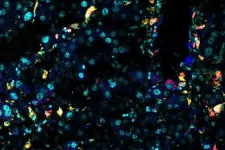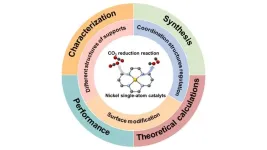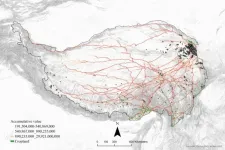(Press-News.org) Highlights
Laboratory research led by MSK and Cold Spring Harbor Laboratory demonstrates the potential for CAR T cells to improve “healthspan” by eliminating senescent cells associated with aging-related diseases.
Not only was the treatment able to improve the metabolic function of aging mice and mice fed a high-fat diet, but it also proved protective against metabolic decline when given to younger mice.
The CAR T cell-based approach offers a powerful alternative to more traditional small-molecule drugs target senescent cells, supported by its long-lasting effects and the potential to fine-tune its targeting.
Chimeric antigen receptor (CAR) T cells have transformed the treatment of blood cancers in recent years. And there have been positive signs the “living drugs” can be harnessed against other diseases, like autoimmune disorders.
Now laboratory research led by Memorial Sloan Kettering Cancer Center (MSK) and Cold Spring Harbor Laboratory suggests these engineered immune cells hold promise for treating some diseases related to aging, as well — specifically, those caused by the accumulation of senescent cells (cells that stop dividing due to age or damage).
An infusion of CAR T cells designed to target senescent cells was not only able to improve metabolic function in older mice and mice prematurely aged by a high-fat diet, but a single dose given to young, healthy mice also helped prevent metabolic decline later in life, according to findings the research team published in Nature Aging.
“When you hear ‘CAR T cell therapy,’ you think ‘cancer’ — and it makes sense that it was pioneered at a place like MSK,” says senior study author Scott Lowe, PhD, Chair of the Cancer Biology and Genetics Program in MSK’s Sloan Kettering Institute. “But what we’re learning is that this approach of engineering immune cells to target disease has much broader possibilities.”
CAR T Treatment Improves Metabolic Function in Mice
In the study, younger mice were fed a high-fat diet for two months, which made them obese and caused metabolic stress. After an infusion of the experimental CAR T cells, the mice had lower body weight, better fasting blood glucose levels, and improved glucose and insulin tolerance, despite continuing the high-fat diet. They also had fewer senescent cells in the pancreas, liver, and fatty tissues than mice in a control group. Similar results were seen in older mice where metabolic function had decreased due to natural aging.
Older mice that received the treatment even took longer to become exhausted when exercising. And the approach didn’t appear to cause any significant side effects.
Further research is needed to see if the approach could extend the life span of the mice in addition to improving their “healthspan” — that is, how long they stay healthy and free of disease, the scientists note.
“We’re continuing to learn new things about senescence on a biological level,” Dr. Lowe says. “It will take time, but we’re interested in working with industry partners to move the laboratory findings into clinical trials.”
There are a number of diseases associated with aging and chronic inflammation that potentially might be helped, Dr. Lowe says, such as chronic obstructive pulmonary disease (COPD), nonalcoholic steatohepatitis (NASH), osteoarthritis, metabolic syndrome, and even certain neurodegenerative diseases.
Along with Dr. Lowe’s lab, immunologist Michel Sadelain, MD, PhD, and members of his lab were key collaborators in the research. Dr. Sadelain is a pioneer in the development of CAR T cell therapy, for which he was recently awarded the 2024 Breakthrough Prize in Life Sciences.
The study was co-led by Inés Fernández-Maestre, a graduate student in the lab of MSK physician-scientist Ross Levine, MD, and by Corina Amor Vegas, MD, PhD, a former graduate student in the Lowe Lab who now heads her own lab at Cold Spring Harbor and is the corresponding author of the paper.
Targeting Senescent Cells With CAR T
A microscope image of an aged mouse liver showing signs of chronic inflammation (clusters of dark purple cells).
Senescent cells are damaged cells that have gone into a protective, shutdown mode, where they stop dividing and actively send “help me” signals to the immune system. This can have some short-term benefits in contexts like wound healing and preventing the runaway cell division that happens in cancer, but it also can lead to chronic inflammation as senescent cells accumulate as people age.
In 2020, researchers at MSK identified a molecule on the surface of senescent cells that was largely absent on other types of cells. This allowed them to design CAR T cells that could recognize and attack that specific molecule, called urokinase plasminogen activator receptor (uPAR). The team successfully tested the approach in several different mouse models of senescence-related diseases, including cancer and liver fibrosis, according to findings they published in Nature.
The new research goes further in demonstrating that senolytic (senescence-targeting) cell therapies can improve symptoms associated with aging.
The uPAR-targeting CAR T cells provide an alternative to the more traditional small-molecule drugs currently being investigated to clear senescent cells, notes Dr. Lowe, who is also a Howard Hughes Medical Institute Investigator.
“One of the challenges with the current small-molecule drugs is that many don’t have a well-understood mechanism of action as it pertains to senescence. And a lot of them are repurposed cancer drugs with substantial toxicities.”
Such drugs also must be given repeatedly.
“T cells, however, have the ability to develop memory and persist in your body for really long periods, which is very different from a chemical drug,” notes Dr. Amor Vegas, who was also a co-first author on the earlier study. “With CAR T cells, you have the potential of getting this one treatment, and then that’s it. For chronic pathologies, that’s a huge advantage. Think about patients who need treatment multiple times per day versus you get an infusion, and then you’re good to go for multiple years.”
Furthermore, with a cellular therapy, it’s possible to engineer in safety features to mitigate side effects as well as simultaneously to target multiple molecules on the surface of cells — reducing the chances of them attacking healthy cells.
Different Challenges Than Using CAR T Cell Against Cancer
Through these experiments, the research team was able to show: uPAR-positive cells increase with age and significantly contribute to aging-related disfunction in tissues; uPAR-targeting CAR T cells can effectively eliminate the senescent cells without major side effects in mice; and that administering the treatment improved metabolism health in both normal aging and diet-related metabolic disease.
Mice normally live about two years, and research found the uPAR-targeting CAR T cells persisted and expanded for more than 15 months in mice as they grew from youth into older age.
“In some ways, using CAR T cells to treat age-associated diseases presents distinct challenges from using these therapies in cancer,” Dr. Lowe says. “If only a few cancer cells survive treatment, they may keep dividing to enable the tumor to relapse. Since senescent cells don’t divide, clearing most but not all of them should still produce substantial health benefits.”
Still, there is a high safety bar for developing therapies for diseases that are less lethal than cancer.
“We continue to develop new strategies to engineer cell therapies to be less toxic and less expensive,” Dr. Sadelain says. “These efforts will undoubtedly expand the list of diseases that can be treated by CAR T cell therapies in the coming years.”
Additional Authors, Funding, and Disclosures
Additional authors include Saria Chowdhury, Sandeep Nadella. Emmanuella Nnuji-John, and David Tuveson of Cold Spring Harbor Laboratory; Yu-Jui Ho, Courtenay Graham, Clemens Hinterleitner, Valentin J. A. Barthet, Riccardo Mezzadra, and Matthew Wereski of MSK; Sebastian Carrasco of MSK, Weill Cornell Medicine, and The Rockefeller University; Judith Feucht of MSK and University Children’s Hospital Tuebingen, Germany; Lee Jones of MSK and Weill Cornell Medicine; and Jacob Boyer of Princeton University.
The research was funded, in part, by the National Institutes of Health (5P30CA45508, U01CA210240, R01CA229699, U01CA224013, 1R01CA188134, 1R01CA190092, S10OD028632-01), the National Cancer Institute (CA197594, 5P30CA045508, P30CA008748, P30CA045508), and the National Institute on Aging (U01AG077925, AG065396, 1R01AG082800-01). Please see the study for a full list of funders.
Drs. Amor Vegas, Feucht, Sadelain, and Lowe are listed as the inventors of several patent applications related to senolytic CAR T cells. Drs. Amor Vegas, Sadelain, and Lowe are advisors for Fate Therapeutics. Several of the others report service on the Scientific Advisory Boards of pharmaceutical companies as well as consulting work. Please see the study for a full list of disclosures.
Read the article: “Prophylactic and long-lasting efficacy of senolytic CAR T cells against age-related metabolic dysfunction,” Nature Aging. DOI: 10.1038/s43587-023-00560-5
END
CAR T cells show promise against age-related diseases in mice
2024-02-02
ELSE PRESS RELEASES FROM THIS DATE:
Clinique partners with Icahn School of Medicine at Mount Sinai to establish the Mount Sinai-Clinique Healthy Skin Dermatology Center
2024-02-02
New York, NY (February 2, 2024) – Clinique and Icahn School of Medicine at Mount Sinai today announced a philanthropic partnership to establish the Mount Sinai-Clinique Healthy Skin Dermatology Center. The Center will develop forward-thinking research in dermatology, exploring the biological underpinnings of how skin ages, skin allergies and inflammatory or eczematous skin conditions, including eczema (or atopic dermatitis) and contact dermatitis. Rooted in a shared mission to conduct dermatological research that improves patients’ lives, the partnership will focus on applicable scientific discovery and leading-edge innovation to modernize allergy science in order to ...
Strategies for enhancing the performance of nickel single-atom catalysts for the electroreduction of CO2 to CO
2024-02-02
Electrocatalytic reduction of carbon dioxide (CO2) is considered as an effective strategy for mitigating the energy crisis and the greenhouse effect. Among the multiple reduction products, CO is regarded as having the highest market value as it is a crucial feedstock for Fischer-Tropsch process which can synthesize high-value long-chain hydrocarbons. Since the carbon dioxide reduction reaction (CO2RR) has complex intermediates and multiple proton-coupled electron transfer processes, improving the reaction activity and products selectivity remain two great challenges.
Single-atom catalysts (SACs) have the advantages of high atom utilization, tunable coordination structure ...
Brexit-induced spatial restrictions reveal alarming increase of fishing fleet’s carbon footprint
2024-02-02
In a study published today in Marine Policy, researchers have unveiled striking evidence that fisheries management decisions such as spatial fisheries restrictions can increase greenhouse gas emissions. The study, conducted by a team of scientists led by postdoctoral researcher Kim Scherrer at the University of Bergen, sheds light on the unforeseen consequences of policy changes on fishing fleets and their carbon footprint.
In the North Atlantic, international agreements often allow fleets to follow the fish across national borders. This allows fishers to catch the fish where it is most efficient. But when the UK left the EU (Brexit), ...
Scammed! Animals ‘led by the nose’ to leave plants alone
2024-02-02
University of Sydney researchers have shown it is possible to shield plants from the hungry maws of herbivorous mammals by fooling them with the smell of a variety they typically avoid.
Findings from the study published in Nature Ecology & Evolution show tree seedlings planted next to the decoy smell solution were 20 times less likely to be eaten by animals.
“This is equivalent to the seedlings being surrounded by actual plants that are unpalatable to the herbivore. In most cases it does trick the animals into leaving the plants alone,” said PhD student Patrick ...
Why are people climate change deniers?
2024-02-02
Do climate change deniers bend the facts to avoid having to modify their environmentally harmful behavior? Researchers from the University of Bonn and the Institute of Labor Economics (IZA) ran an online experiment involving 4,000 US adults, and found no evidence to support this idea. The authors of the study were themselves surprised by the results. Whether they are good or bad news for the fight against global heating remains to be seen. The study is being published in the journal Nature Climate Change. STRICTLY EMBARGOED: Do not publish before Friday, February 02, 11 a.m. CET!
A surprisingly large number of people ...
Epigenetic status determines metastasis
2024-02-02
Scientists from the German Cancer Research Center (DKFZ) and Heidelberg University investigated in mice how spreading tumor cells behave at the site of metastasis: Some tumor cells immediately start to form metastases. Others leave the blood vessel and may then enter a long period of dormancy. What determines which path the cancer cells take is their epigenetic status. This was also confirmed in experiments with human tumor cells. The results of the study could pave the way for novel diagnostic and therapeutic applications.
What makes cancer so dangerous? ...
Prehistoric mobility among Tibetan farmers, herders shaped highland settlement patterns, cultural interaction, study finds
2024-02-02
The 1 million-square-mile Tibetan Plateau — often called the “roof of the world” — is the highest landmass in the world, averaging 14,000 feet in altitude. Despite the extreme environment, humans have been permanent inhabitants there since prehistoric times.
Farming and herding play major roles in the economy of the Tibetan Plateau today — as they have throughout history. To make the most of a difficult environment, farmers, agropastoralists and mobile herders interact and move in conjunction with one another, which in turn shapes ...
World Wetlands Day: Bogs hold an important key to the climate crisis
2024-02-02
World Wetlands Day: Bogs hold an important key to the climate crisis
Peat bogs store twice as much CO2 as all of the world's forests combined. A new research center at the University of Copenhagen will map Earth’s wetlands and provide important knowledge about the greenhouse gas budgets of these areas. The Global Wetland Center will teach us how to contain carbon from plants and trees in bogs and other wetlands – and preserve it as well as the ancient bog bodies also found there.
He is world-renowned ...
Natural therapy shows promise for dry-eye disease
2024-02-02
Researchers at the University of Auckland are running a trial of castor oil as a potential safe and natural treatment for dry-eye disease following a successful pilot study.
While exact figures aren’t available for New Zealand, in Australia, it is estimated dry-eye disease affects around 58 percent of the population aged over 50.
Advancing age, menopause, increased screen time, contact lens wear are just some of the risk factors for developing dry eye disease.
Blepharitis is the most common cause of dry-eye disease, accounting for more than 80 percent of cases. It is a chronic condition with no known cure.
“Currently, patients ...
Researchers study role of post-transcriptional splicing in plant response to light
2024-02-02
In a study recently published in the PNAS on Jan. 30, a research team led by Prof. CAO Xiaofeng from the Institute of Genetics and Developmental Biology of the Chinese Academy of Sciences, in collaboration with researchers from the Southern University of Science and Technology, reported a new understanding of how light affects plant growth.
Light plays a central role in plant growth and development, providing an energy source and governing various aspects of plant morphology. Post-transcriptional splicing (PTS) has been previously discovered to generate polyadenylated full-length transcripts. These transcripts, ...






